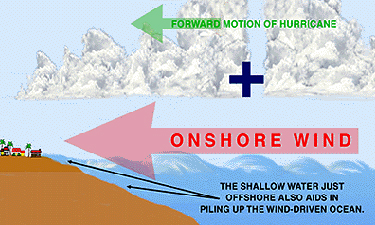|
|
CDEMA Tsunami Preparedness - Storm Surge
| Storm Surge |
|
Of the several coastal hazards affecting CDEMA Participating States, the storm surge hazard causes the most significant impact on life, the economy and the environment annually throughout the Caribbean region.
A storm surge is the unusual rise in sea level usually associated with hurricanes and tropical storms prior to and during landfall. Storm surges are caused primarily by high winds pushing on the ocean’s surface. This causes the water to pile up higher than the ordinary sea level. Tropical cyclone-induced storm tides can increase the mean water level 5 meters or more.
 The main force creating the storm surge at the time the hurricane or tropical storm makes landfall is the wind driving the ocean ashore. The ocean creates frictional drag for the wind and therefore piles up against the coastline. The main force creating the storm surge at the time the hurricane or tropical storm makes landfall is the wind driving the ocean ashore. The ocean creates frictional drag for the wind and therefore piles up against the coastline.Storm surge is responsible for much of the damage caused by severe weather systems, especially in large, low-lying coastal settlements. According to the US National Weather Service’s National Hurricane Center, “the greatest potential for loss of life related to a hurricane is from storm surge.”
Storm impact is expected to worsen in the future due to increased cyclone activity and heightened storm surges. These surges will, in turn, create more damaging flood conditions in low-lying coastal areas.
Storm Surge - What Can You Do?
Residents living in coastal areas threatened by tropical storms and hurricanes should understand the dangers these events pose to their families and properties. When a tropical storm or hurricane threatens the area, the Meteorological Services Office forecasts expected storm surge heights and the Disaster Management Organisation will provide advice to the public. This process involves consultation with a number of government and non-government agencies and coastal users to ensure that the forecasts and advice provided to the public is based on accurate information.
A protocol provides formal guidance and procedures to be followed. The storm surge warning information dissemination protocol is intended to formally lay out the responsibility of specific agencies within the national disaster management systems to receive severe weather bulletins with storm surge potential from the National Oceanic and Atmospheric Administration’s National Weather Service, National Hurricane Center (NOAA NWS NHC), and then in turn analyse and process these bulletins, to appropriately alert respective regional and national agencies as well as the public about impending storm surges. The figure provides a summary illustration of the process.
For more information on storm surge and what to do, please read the Township Planning Strategies for Storm Surge Toolkit developed by CDEMA/CCCCC/CIMH (2007). The Township Planning Strategies for Storm Surge Toolkit provides criteria and guidelines for sound risk management and adaptation strategies using the approach and findings of pilot studies conducted in Portmore, Jamaica and St. Peter, Barbados, as well as, documentation on strategies for disaster risk management and for climate change adaptation in other parts of the Caribbean.
Residents should use these forecasts and heed the advice to guide any necessary evacuation decisions.
Click to listen to the Storm Surge PSA
|
_01.png)






